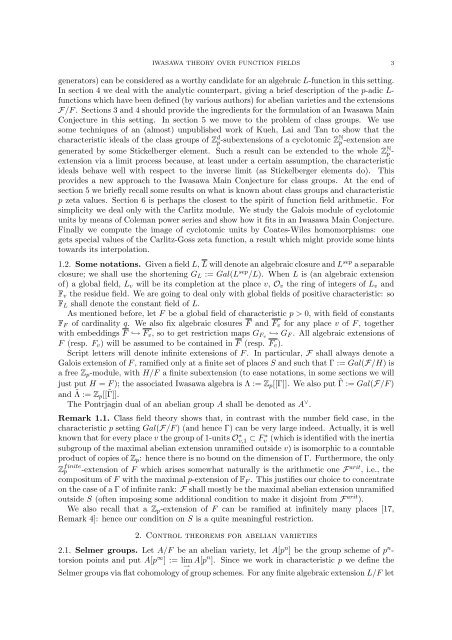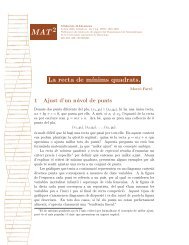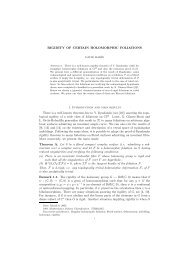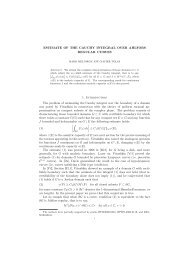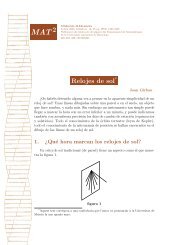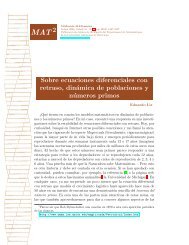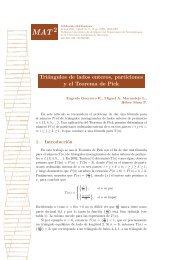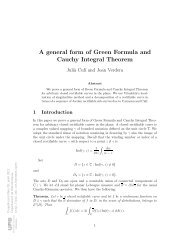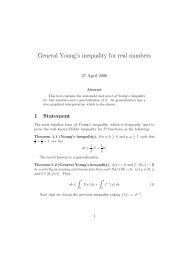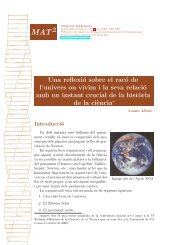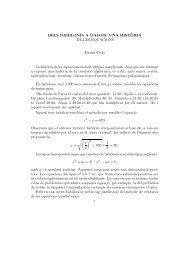ASPECTS OF IWASAWA THEORY OVER FUNCTION FIELDS 1 ...
ASPECTS OF IWASAWA THEORY OVER FUNCTION FIELDS 1 ...
ASPECTS OF IWASAWA THEORY OVER FUNCTION FIELDS 1 ...
You also want an ePaper? Increase the reach of your titles
YUMPU automatically turns print PDFs into web optimized ePapers that Google loves.
<strong>IWASAWA</strong> <strong>THEORY</strong> <strong>OVER</strong> <strong>FUNCTION</strong> <strong>FIELDS</strong> 3generators) can be considered as a worthy candidate for an algebraic L-function in this setting.In section 4 we deal with the analytic counterpart, giving a brief description of the p-adic L-functions which have been defined (by various authors) for abelian varieties and the extensionsF/F . Sections 3 and 4 should provide the ingredients for the formulation of an Iwasawa MainConjecture in this setting. In section 5 we move to the problem of class groups. We usesome techniques of an (almost) unpublished work of Kueh, Lai and Tan to show that thecharacteristic ideals of the class groups of Z d p-subextensions of a cyclotomic Z N p -extension aregenerated by some Stickelberger element. Such a result can be extended to the whole Z N p -extension via a limit process because, at least under a certain assumption, the characteristicideals behave well with respect to the inverse limit (as Stickelberger elements do). Thisprovides a new approach to the Iwasawa Main Conjecture for class groups. At the end ofsection 5 we briefly recall some results on what is known about class groups and characteristicp zeta values. Section 6 is perhaps the closest to the spirit of function field arithmetic. Forsimplicity we deal only with the Carlitz module. We study the Galois module of cyclotomicunits by means of Coleman power series and show how it fits in an Iwasawa Main Conjecture.Finally we compute the image of cyclotomic units by Coates-Wiles homomorphisms: onegets special values of the Carlitz-Goss zeta function, a result which might provide some hintstowards its interpolation.1.2. Some notations. Given a field L, L will denote an algebraic closure and L sep a separableclosure; we shall use the shortening G L := Gal(L sep /L). When L is (an algebraic extensionof) a global field, L v will be its completion at the place v, O v the ring of integers of L v andF v the residue field. We are going to deal only with global fields of positive characteristic: soF L shall denote the constant field of L.As mentioned before, let F be a global field of characteristic p > 0, with field of constantsF F of cardinality q. We also fix algebraic closures F and F v for any place v of F , togetherwith embeddings F ↩→ F v , so to get restriction maps G Fv ↩→ G F . All algebraic extensions ofF (resp. F v ) will be assumed to be contained in F (resp. F v ).Script letters will denote infinite extensions of F . In particular, F shall always denote aGalois extension of F , ramified only at a finite set of places S and such that Γ := Gal(F/H) isa free Z p -module, with H/F a finite subextension (to ease notations, in some sections we willjust put H = F ); the associated Iwasawa algebra is Λ := Z p [[Γ]]. We also put ˜Γ := Gal(F/F )and ˜Λ := Z p [[˜Γ]].The Pontrjagin dual of an abelian group A shall be denoted as A ∨ .Remark 1.1. Class field theory shows that, in contrast with the number field case, in thecharacteristic p setting Gal(F/F ) (and hence Γ) can be very large indeed. Actually, it is wellknown that for every place v the group of 1-units Ov,1 ∗ ⊂ F v ∗ (which is identified with the inertiasubgroup of the maximal abelian extension unramified outside v) is isomorphic to a countableproduct of copies of Z p : hence there is no bound on the dimension of Γ. Furthermore, the onlyZ finitep-extension of F which arises somewhat naturally is the arithmetic one F arit , i.e., thecompositum of F with the maximal p-extension of F F . This justifies our choice to concentrateon the case of a Γ of infinite rank: F shall mostly be the maximal abelian extension unramifiedoutside S (often imposing some additional condition to make it disjoint from F arit ).We also recall that a Z p -extension of F can be ramified at infinitely many places [17,Remark 4]: hence our condition on S is a quite meaningful restriction.2. Control theorems for abelian varieties2.1. Selmer groups. Let A/F be an abelian variety, let A[p n ] be the group scheme of p n -torsion points and put A[p ∞ ] := lim→A[p n ]. Since we work in characteristic p we define theSelmer groups via flat cohomology of group schemes. For any finite algebraic extension L/F let


